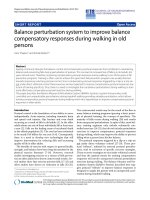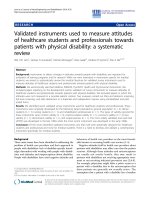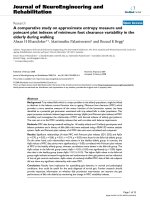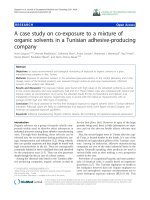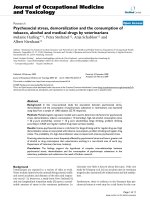Báo cáo hóa học: " A fixed-point approach to the stability of a functional equation on quadratic forms" doc
Bạn đang xem bản rút gọn của tài liệu. Xem và tải ngay bản đầy đủ của tài liệu tại đây (206.74 KB, 7 trang )
RESEARCH Open Access
A fixed-point approach to the stability of a
functional equation on quadratic forms
Jae-Hyeong Bae
1
and Won-Gil Park
2*
* Correspondence:
2
Department of Mathematics
Education, College of Education,
Mokwon University, Daejeon, 302-
729, Korea
Full list of author information is
available at the end of the article
Abstract
Using the fixed-point method, we prove the generalized Hye rs-Ulam stability of the
functional equation
f (x + y, z + w)+f (x − y, z − w)=2f (x, z)+2f (y, w).
The quadratic form f : ℝ × ℝ ® ℝ given by f(x, y)=ax
2
+ bxy + cy
2
is a solution of
the above functional equation.
Keywords: alternative of fixed point, functional equation, quadratic form, stability
1. Introduction
In 1940, S. M . Ulam [1] gave a wide-ranging talk before the Mathematics Club of the
University of Wisconsin in which he discussed a number of important unsolved pro-
blems. Among those was the question concerning the stability of group
homomorphisms:
Let G
1
beagroupandletG
2
be a metric group with the metric d(· , ·).Givenε >0,
does there exist a δ >0 such that if a function h : G
1
® G
2
satisfies the inequality d(h
(xy), h(x)h(y)) < δ for all x, y Î G
1
, then there is a homomorphism H : G
1
® G
2
with d
(h(x), H(x)) < ε for all x Î G
1
?
The case of approximat ely additive mapp ings was solved by D. H. Hyers [2] under
the assumption that G
1
and G
2
are Banach spaces. Thereafter, many authors investi-
gated solutions or stability of various functional equations (see [3-11]).
Let X be a set. A function d : X × X ® [0, ∞] is called a generalized metric on X if d
satisfies
(1) d(x, y) = 0 if and only if x = y;
(2) d(x, y)=d(y, x) for all x, y Î X;
(3) d(x, z) ≤ d(x, y)+d(y, z) for all x, y, z Î X.
Note that the only substantial difference of the generalized metric from the metric is
that the range of generalized metric includes the infinity.
Throughout this paper, let X and Y be two real vector spaces and let : X × X × X ×
X ® [0, ∞) be a fu nction. For a mapping f : X × X ® Y,
consider the functional equa-
tion:
f (x + y, z + w)+f (x − y, z − w)=2f (x, z)+2f (y, w).
(1:1)
Bae and Park Journal of Inequalities and Applications 2011, 2011:82
/>© 2011 Bae and Park; licensee Springer. This is an Open Access article distributed under the terms of the Creative Commons
Attribution License ( g/licenses/by/2.0), which perm its unrestricted use, distribution, and reproduction in
any medium, pro vided the original work is properly cited.
The quadratic form f : ℝ × ℝ ® ℝ given by f(x, y):=ax
2
+ bxy + cy
2
is a solution of
the Equation 1.1.
The authors [12] acquired the general solution and proved the stability of the func-
tional Equation 1.1 for the case that X and Y are real vector spaces as follows.
Theorem A. A mapping f : X × X ® Y satisfies the Equation 1.1 for all x, y, z, w Î X
if and only if there exist two symmetric bi-additive mapp ings S, T : X × X ® Yanda
bi-additive mapping B : X × X ® Y such that
f (x, y)=S(x, x)+B(x, y)+T(y, y)
for all x, y Î X.
From now on, let Y be a complete normed space.
Theorem B. Assume that satisfies the condition
˜ϕ(x, y, z, w):=
∞
j=0
1
4
j+1
ϕ(2
j
x,2
j
y,2
j
z,2
j
w) < ∞
for all x, y, z, w Î X. Let f : X × X ® Y be a mapping such that
f (x + y, z + w)+f (x − y, z − w) − 2f (x, z) − 2f (y, w) ≤ϕ(x, y, z, w)
for all x, y, z, w Î X. Then, there exists a unique mapping F : X × X ® Ysatisfying
the Equation 1.1 such that
f (x, y) − F(x, y) ≤ ˜ϕ(x, x, y, y)
(1:2)
for all x, y Î X. The mapping F is given by
F( x , y) := lim
j→∞
1
4
j
f (2
j
x,2
j
y)
for all x, y Î X.
In this paper, we prove the stability of the Equation 1.1 using the fixed-point
method.
2. Stability using the alternative of fixed point
In this section, we investigate the stability of the functional Equation 1.1 using the
alternative of fixed point. Before proceeding the proof, we will state the theorem, the
alternative of fixed point.
Theorem 2.1.(The alternative of fixed point [13,14]). Suppose that we are given a
complete generalized metric space (Ω, d) and a strictly contractive mapping T : Ω ®
Ω with Lipschitz constant L. Then, for each given x Î Ω, either
d(T
n
x, T
n+1
x)=∞ for all n ≥ 0,
or
there exists a positive integer n
0
such that
• d(T
n
x, T
n+1
x) <∞ for all n ≥ n
0
;
• the sequence (T
n
x) is convergent to a fixed point y* of T;
• y* is the unique fixed point of T in the set
= {y ∈ | d(T
n
0
x, y) < ∞}
;
•
d(y, y
∗
) ≤
1
1−L
d(y, Ty )
for all y Î Δ.
Bae and Park Journal of Inequalities and Applications 2011, 2011:82
/>Page 2 of 7
Lemma 2.2. Let ψ : X × X ® [0, ∞) be a function given by
ψ(x, y):=ϕ
x
2
,
x
2
,
y
2
,
y
2
for all x, y Î X. Consider the set Ω :={g | g : X × X ® Y, g(0, 0) = 0} and the gener-
alized metric d on Ω given by
d(g, h)=d
ψ
(g, h):=infS
ψ
(g, h),
where S
ψ
(g, h):={K Î [0, ∞]|||g(x, y) -h(x, y)||≤ Kψ(x, y) for all x, y Î X} for all
g, h Î Ω. Then,(Ω, d) is complete.
Proof. Let {g
n
} be a Cauchy sequence in (Ω, d). Then, given ε >0, there exists N such
that d(g
n
, g
k
) < ε if n, k ≥ N.Letn, k ≥ N.Sinced(g
n
, g
k
)=infS
ψ
( g
n
, g
k
) < ε,there
exists K Î [0, ε) such that
g
n
(x, y) − g
k
(x, y) ≤Kψ(x, y) ≤ εψ(x, y)
(2:1)
for all x, y Î X. So, for each x , y Î X,{g
n
(x, y)} is a Cauchy sequence in Y. Since Y is
complete, for each x, y Î X, there exists g (x, y) Î Y such that g
n
(x, y) ® g(x, y)asn ®
∞ and g(0, 0) = 0. Thus, we have g Î Ω. By (2.1), we obtain that
n ≥ N ⇒ g
n
(x, y) − g(x, y) ≤εψ(x, y)forallx, y ∈
X
⇒ ε ∈ S
ψ
(g
n
, g)
⇒ d(g
n
, g)=infS
ψ
(g
n
, g) ≤ ε.
Hence, g
n
® g Î Ω as n ® ∞.
By using an idea of Cădariu and Radu (see [15]), we will prove the Hyers-Ulam stabi-
lity of the functional equation related to quadratic forms.
Theorem 2.3. Assume that satisfies the condition
lim
n→∞
1
4
n
ϕ(2
n
x,2
n
y,2
n
z,2
n
w)=0
for all x, y, z, w Î X. Suppose tha t a mapping f : X × X ® Y satisfies the functional
inequality
f (x + y, z + w)+f (x − y, z − w) − 2f (x, z) − 2f (y, w) ≤ϕ(x, y, z, w)
(2:2)
for all x, y, z, w Î Xandf(0, 0) = 0.IfthereexistsL<1 such that the function ψ
given in Lemma 2.2 has the property
ψ(x, y) ≤ 4Lψ
x
2
,
y
2
(2:3)
for a ll x, y Î X, then there exists a unique mapping F : X × X ® Ysatisfying(1.1)
such that the inequality
f (x, y) − F(x, y) ≤
L
1 − L
ψ(x, y)
(2:4)
holds for all x, y Î X.
Proof. Consider the complete generalized metric space (Ω, d) given in Lemma 2.2.
Now we define a mapping T : Ω ® Ω by
Bae and Park Journal of Inequalities and Applications 2011, 2011:82
/>Page 3 of 7
Tg(x, y):=
1
4
g(2x,2y)
for all g Î Ω and all x, y Î X. Observe that, for all g, h Î Ω,
K
∈ S
ψ
(g, h)andK
< K
⇒g(x, y) − h(x, y) ≤K
ψ(x, y) ≤ Kψ(x, y)forallx, y ∈ X
⇒ K ∈ S
ψ
(g, h).
Let g, h Î Ω and ε Î (0, ∞]. Then, there is a K’ Î S
ψ
(g, h) such that K’ <d(g, h)+ε.
By the above observation, we gain d(g, h)+ε Î S
ψ
(g, h). So we get ||g(x, y) -h(x, y)|| ≤
(d(g, h)+ε) ψ (x, y) for all x, y Î X. Thus, we have
1
4
g(2x,2y) −
1
4
h(2x,2y) ≤
1
4
(d(g, h)+ε)ψ(2x,2y)
for all x, y Î X. By (2.3), we obtain that
1
4
g(2x,2y) −
1
4
h(2x,2y) ≤ L(d(g, h)+ε) ψ ( x , y)
for all x, y Î X. Hence, d(Tg, Th) ≤ L (d(g, h)+ε). Now we obtain that
d(Tg, Th) ≤ L(d(g, h)+ε)
for all ε Î (0, ∞]. Taking the limit as ε ® 0
+
in the above inequality, we get
d(Tg, Th) ≤ Ld(g, h)
for all g, h Î Ω,thatis,T is a strictly contractive mapping of Ω with Lipschitz con-
stant L.
Putting y = x and w = z in (2.2), by (2.3), we have the inequality
f (x, z) −
1
4
f (2x,2z)
≤
1
4
ϕ(x, x, z, z)=
1
4
ψ(2x,2z) ≤ Lψ(x, z)
(2:5)
for all x, z Î X. Thus, we obtain that
d(f , Tf ) ≤ L < ∞.
(2:6)
Applying the alternative of fixed point, we see that there exists a fixed point F of T
in Ω such that
F( x , y) = lim
n→∞
1
4
n
f (2
n
x,2
n
y)
for all x, y Î X. Replacing x, y, z, w by 2
n
x,2
n
y,2
n
z,2
n
w in (2.2), respectively, and
dividing by 4
n
, we have
F(x + y, z + w)+F(x − y, z − w) − 2F(x, z) − 2F(y, w)
= lim
n→∞
1
4
n
f (2
n
(x + y), 2
n
(z + w)) + f (2
n
(x − y), 2
n
(z − w))
−2f (2
n
x,2
n
z) − 2f(2
n
y,2
n
w)
≤ lim
n→∞
1
4
n
ϕ(2
n
x,2
n
y,2
n
z,2
n
w)=0
Bae and Park Journal of Inequalities and Applications 2011, 2011:82
/>Page 4 of 7
for all x, y, z, w Î X. Thus, the mapping F satisfies the Equation 1.1. By (2.3) and
(2.5), we obtain that
T
n
f (x, y) − T
n+1
f (x, y) =
1
4
n
f (2
n
x,2
n
y) −
1
4
f (2
n+1
x,2
n+1
y)
≤
L
4
n
ψ(2
n
x,2
n
y) ≤··· ≤
L
4
n
(4L)
n
ψ(x, y
)
= L
n+1
ψ
(
x, y
)
for all x, y Î X and all n Î N, that is, d(T
n
f, T
n+1
f) ≤ L
n+1
<∞ for all n Î N.Bythe
fixed-point alternative, there exists a natural number n
0
such that the mapping F is the
unique fixed point of T in the set
= {g ∈ |d(T
n
0
f , g) < ∞}
.Sowehave
d(T
n
0
f , F) < ∞
. Since
d(f , T
n
0
f ) ≤ d(f, Tf)+d(Tf, T
2
f )+···+ d(T
n
0
−1
f , T
n
0
f ) < ∞,
we get f Î Δ. Thus, we have
d(f , F ) ≤ d(f, T
m
0
f )+d(T
m
0
f , F) < ∞
. Hence, we obtain
||f (x, y) − F ( x , y)|| ≤ Kψ (x, y)
for all x Î X and some K Î [0, ∞). Again using the fixed-point alternative, we have
d(f , F ) ≤
1
1 − L
d(f , Tf ).
By (2.6), we may conclude that
d(f , F ) ≤
L
1 − L
,
which implies the inequality (2.4).
Lemma 2.4. Let ψ : X × X ® [0, ∞) be a function given by
ψ(x, y):=ϕ(2x,2x,2y,2y)
for all x, y Î X. Consider the set Ω :={g | g : X × X ® Y, g(0, 0) = 0} and the gener-
alized metric d on Ω given by
d(g, h)=d
ψ
(g, h):=infS
ψ
(g, h),
where S
ψ
(g, h):=K Î [0, ∞]|||g(x, y) -h(x, y)|| ≤ Kψ(x, y) for all x, y Î X} for all g,
h Î Ω. Then,(Ω, d) is complete.
Proof. The proof is similar to the proof of Lemma 2.2.
Theorem 2.5. Assume that satisfies the condition
lim
n→∞
4
n
ϕ
x
2
n
,
y
2
n
,
z
2
n
,
w
2
n
=0
for all x, y, z, w Î X. Suppose tha t a mapping f : X × X ® Y satisfies the functional
inequality (2.2) for a ll x, y, z, w Î Xandf(0, 0) = 0.IfthereexistsL<1 such tha t the
function ψ given in Lemma 2.4 has the property
ψ(x, y) ≤
L
4
ψ(2x,2y)
(2:7)
Bae and Park Journal of Inequalities and Applications 2011, 2011:82
/>Page 5 of 7
for a ll x, y Î X, then there exists a unique mapping F : X × X ® Ysatisfying(1.1)
such that the inequality
f (x, y) − F(x, y) ≤
L
2
16(1 − L)
ψ(x, y)
(2:8)
holds for all x, y Î X.
Proof. Consider the complete generalized metric space (Ω, d) given in Lemma 2.4.
Now we define a mapping T : Ω ® Ω by
Tg(x, y):=4g
x
2
,
y
2
for all g Î Ω and all x, y Î X. By the same argument of the proof of Theorem 2.3, T
is a strictly contractive mapping of Ω with Lipschitz constant L.
Replacing x, y, z , w by
x
2
,
x
2
,
z
2
,
z
2
in (2.2), respectively, and using (2.7), we have the
inequality
f (x, z) − 4f
x
2
,
z
2
≤ ϕ
x
2
,
x
2
,
z
2
,
z
2
= ψ
x
4
,
z
4
≤
L
4
ψ
x
2
,
z
2
≤
L
2
16
ψ(x, y)
(2:9)
for all x, z Î X. Thus, we obtain that
d(f , Tf ) ≤
L
2
16
< ∞.
(2:10)
Applying the alternative of fixed point, we see that there exists a fixed point F of T
in Ω such that
F( x , y) = lim
n→∞
4
n
f
x
2
n
,
y
2
n
for all x, y Î X.Replacingx, y, z, w by
x
2
n
,
y
2
n
,
z
2
n
,
w
2
n
in (2.2), respectively, and multi-
plying by 4
n
, we have
F( x + y, z + w)+F(x − y, z − w) − 2F(x, z) − 2F(y, w)
= lim
n→∞
4
n
f
x + y
2
n
,
z + w
2
n
+ f
x − y
2
n
,
z − w
2
n
− 2f
x
2
n
,
z
2
n
− 2f
y
2
n
,
w
2
n
≤ lim
n→∞
4
n
ϕ
x
2
n
,
y
2
n
,
z
2
n
,
w
2
n
=0
for all x, y, z, w Î X. Thus, the mapping F satisfies the Equation 1.1. By (2.7) and
(2.9), we obtain that
||T
n
f (x, y) − T
n+1
f (x, y)|| =4
n
f
x
2
n
,
y
2
n
− 4f
x
2
n+1
,
y
2
n+1
≤ 4
n−2
L
2
ψ
x
2
n
,
y
2
n
≤ 4
n−3
L
3
ψ
x
2
n−1
,
y
2
n−1
≤··· ≤
L
n+2
1
6
ψ(x, y)
for all x, y Î X and all n Î N, that is,
d(T
n
f , T
n+1
f ) ≤
L
n+2
16
< ∞
for all n Î N. By the
same reasoning of the proof of Theorem 2.3, we have
Bae and Park Journal of Inequalities and Applications 2011, 2011:82
/>Page 6 of 7
d(f , F ) ≤
1
1 − L
d(f , Tf ).
By (2.10), we may conclude that
d(f , F ) ≤
L
2
16(1 − L)
,
which implies the inequality (2.8).
Acknowledgements
The authors would like to thank the referee for a number of valuable suggestions regarding a previous version of this
paper.
Author details
1
Graduate School of Education, Kyung Hee University, Yongin, 446-701, Korea
2
Department of Mathematics Education,
College of Education, Mokwon University, Daejeon, 302-729, Korea
Authors’ contributions
Both authors contributed equally to this work. The authors read and approved the final manuscript.
Competing interests
The authors declare that they have no competing interests.
Received: 15 April 2011 Accepted: 10 October 2011 Published: 10 October 2011
References
1. Ulam, SM: A Collection of Mathematical Problems. pp. 63. Interscience Publishers, New York (1968)
2. Hyers, DH: On the stability of the linear functional equation. Proc Natl Acad Sci USA. 27, 222–224 (1941). doi:10.1073/
pnas.27.4.222
3. Bae, J-H, Park, W-G: On stability of a functional equation with n variables. Nonlinear Anal TMA. 64, 856–868 (2006).
doi:10.1016/j.na.2005.06.028
4. Bae, J-H, Park, W-G: On a cubic equation and a Jensen-quadratic equation. Abstr Appl Anal 2007 (2007). Article ID
45179
5. Găvruta, P: A generalization of the Hyers-Ulam-Rassias stability of approximately additive mappings. J Math Anal Appl.
184, 431–436 (1994). doi:10.1006/jmaa.1994.1211
6. Jung, S-M: Hyers-Ulam-Rassias Stability of Functional Equations in Nonlinear Analysis. Springer, New York (2011)
7. Jung, S-M, Kim, T-S: A fixed point approach to the stability of the cubic functional equation. Bol Soc Mat Mexicana
12(1), 51–57 (2006). (3)
8. Jung, S-M, Kim, T-S, Lee, K-S: A fixed point approach to the stability of quadratic functional equation. Bull Korean Math
Soc. 43, 531–541 (2006)
9. Jung, S-M, Lee, Z-H: A fixed point approach to the stability of quadratic functional equation with involution. Fixed Point
Theory Appl 2008, 11 (2008). Article ID 732086
10. Park, W-G, Bae, J-H: A multidimensional functional equation having quadratic forms as solutions. J Inequal Appl 2007
(2007). Article ID 24716
11. Rassias, TM: On the stability of linear mappings in Banach spaces. Proc Amer Math Soc. 72, 297–300 (1978). doi:10.1090/
S0002-9939-1978-0507327-1
12. Park, W-G, Bae, J-H: A functional equation originating from quadratic forms. J Math Anal Appl. 326, 1142–1148 (2007).
doi:10.1016/j.jmaa.2006.03.023
13. Margolis, B, Dias, JB: A fixed point theorem of the alternative for contractions on a generalized complete metric space.
Bull Amer Math Soc. 74, 305–309 (1968). doi:10.1090/S0002-9904-1968-11933-0
14. Rus, IA: Principles and Applications of Fixed Point Theory. (1979) in Romanian
15. Cădariu, L, Radu, V: Fixed points and the stability of Jensen’s functional equation. J Inequal Pure Appl Math 4 (2003).
Article 4
doi:10.1186/1029-242X-2011-82
Cite this article as: Bae and Park: A fixed-point approach to the stability of a functional equation on quadratic
forms. Journal of Inequalities and Applications 2011 2011:82.
Bae and Park Journal of Inequalities and Applications 2011, 2011:82
/>Page 7 of 7


